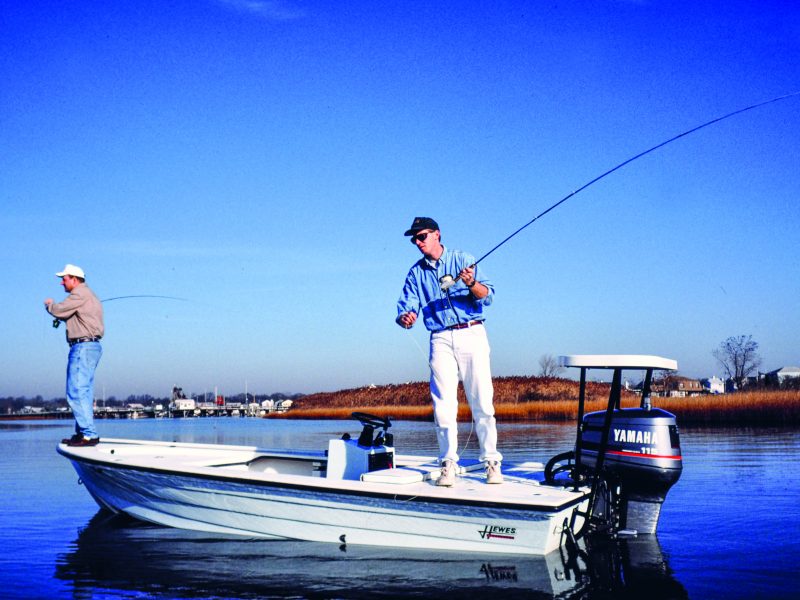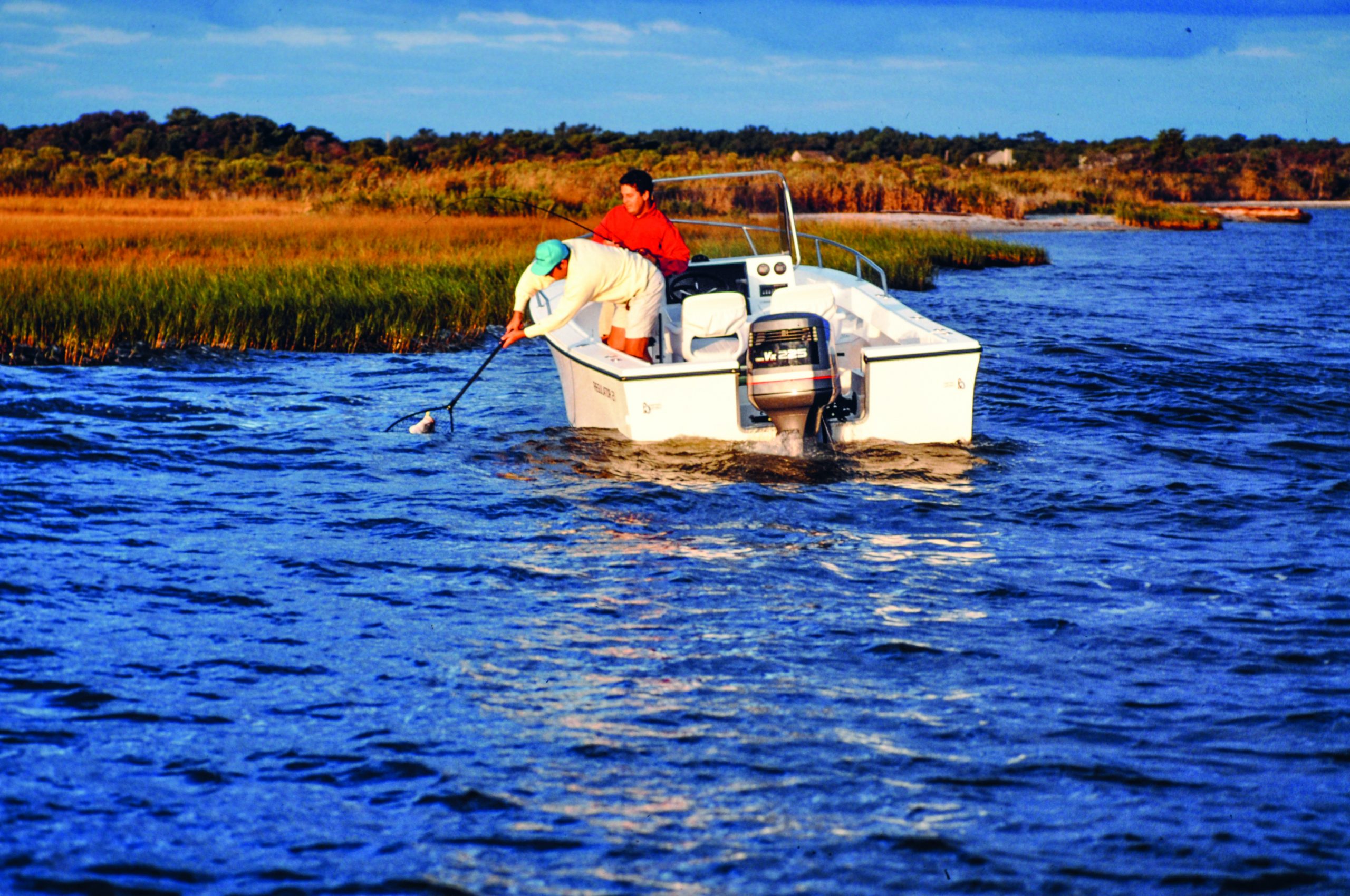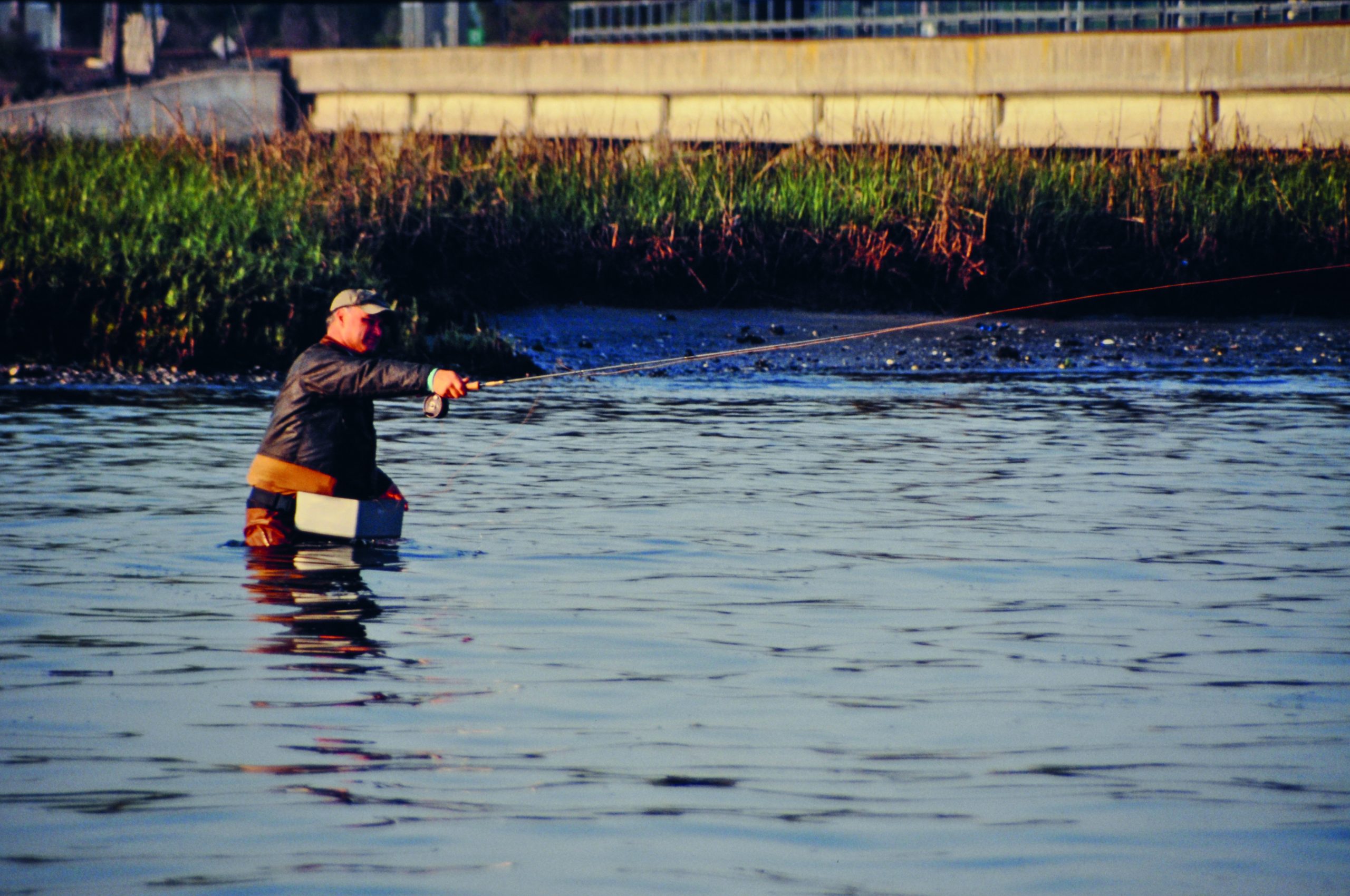Striper Fly Fishing: Improving Casting Presentation
Dial-in your success rate with the best saltwater fly presentations for migrating stripers.

Fall ushers in fast-paced fly-fishing opportunities if you have the right presentation.
“Presentation is 99% of the game once you become a proficient caster,” says Capt. Craig Cantelmo of Fin-Addict Fishing and Van Staal Reels. His advice is uniquely true as the fall season wraps the salty coast with crisp weather, exciting blitzes, and schools of migrating striped bass, bluefish, and false albacore – maybe even a few bouts with weakfish. As bait and gamefish pour out of the backwaters, coastal flyrodders have some of the season’s best fly-fishing opportunities. Dial-up your success rate with the best fly presentations.
So much emphasis is placed on casting that it’s easy to forget the essential importance of presenting the fly, the very thing that will be accepted by the fish at the strike or laughed at with a refusal. An amazing 100-foot cast may get hand-clapping approval from your fishing buddies, but it’s not always distance that counts. How you make the fly come alive is the magic potion that catches fish. At a fly-fishing seminar, Ed Mitchell, well-known author and long-time New England fly-fishing pioneer, told his audience that a 50-foot cast can often be more effective than a long cast if the fly is worked properly.
Ed also talked about sending his fly through just about every square foot of the water wherever he’s fishing. This is especially true with late-summer and early-fall striped bass. Casts made willy-nilly without a plan are just about as effective as standing on one spot, making the same one-direction cast right in front of you over and over again with no variation. Having a strategy in mind to cover all the water in front of you—right, center and left—and different depths will always get the most bites.
Fan Casting
Many fly guys use the term ‘fan-casting’ to describe how they methodically work the water. Captain Ray Szulczewski, retired skipper of the Tide Runner, believes, “Fan-casting is always a good idea. It enables you to cover more area and work structure at more angles. Most of the time, when blind casting, there is some sort of structure involved. It could be a sod bank, the jetty you are standing on, the drop-off past the breaking waves, or the edge of a sandbar. By fan-casting, you can present your fly at many different angles. Fish may be deep, right at your feet, or running parallel to where you are casting. By fan-casting, you can cover all directions the fish might be facing.”
Ed Mitchell also uses the fan-casting approach, but before he starts, he pauses to examine the water in front of him. Sometimes, he’s greeted with breaking fish, perhaps bait dimpling the water’s surface or birds hovering and searching for a meal, so he pays special attention to the very edge of the water. In the surf and at the edge of many backcountry waters, the natural impulse for many flyrodders is to immediately wade in to their knees (or deeper). However, by the time they get that deep, the bass may actually be behind them, or they may have waded right through their holding station and spooked them.

and drop-offs will pay off with more bites.
One morning at Fisherman’s Cove Park inside the Manasquan Inlet, a fly fisherman had waded out quite far on a dropping tide. I guess he was working the deep edge, but there was better fishing right at the water’s edge. Standing on the gravelly shore, not even ankle deep, I had three solid hook-ups, and landed each of them, as bass corralled rainfish not even a 30-foot cast away. All I needed was a roll cast to reach the bait and swirling bass.
Once you’ve selected a place to fish, fan casting forces you to think about how to deliver the fly to every possible spot that striped bass could be positioned as they wait for the tide to serve dinner – or where they might be traveling along a route from one spot to another. Let’s say you are on a sandy beach inside an inlet with a dropping tide and current coming from the left. Make the first cast up-current with a short line, about 40 feet, let the current swim the fly, and at the end of the swing, retrieve it in short strips. Make the next cast about 10 feet down-current, to the right of the first cast, and continue this approach for another four or five casts until the last one is nearly parallel to the beach.
To continue the fan-cast search, strip out about 10 more feet of line and begin the process all over again, starting up-current and working successive casts down-current. Repeat until you’ve made several incrementally longer fly deliveries and have reached your maximum casting distance. The hardest part of this searching technique is to keep your initial casts short. Most of us are mentally programmed to attempt long casts, and starting off short seems unnatural, maybe even foolish. It’s mentally tough to keep the line short without reaching out a little bit further on each new cast. However, to cover all the water, lengthen your casts only after completing the entire arc of the fan-cast before increasing the length to about 50 feet, then 60 feet on the third arc, and eventually out to 70 or 80 feet.
Mending
Depending on the current, it may be a challenge to keep tight to the fly. Usually, the current is faster at the end of the casting distance and slower closer to shore, which causes the head of the fly line to speed up and puts slack in the running line. Avoiding slack line is essential to feeling the fish strike. Out east on Long Island, where sight-fishing opportunities abound, Cantelmo says, “When sight-fishing, mending the line or presenting the fly to the fish is paramount to success. To achieve this, you need to know where the fly is and strip it to keep a bass interested and induce a strike. I can’t tell you how many times a fish eats while coming at the fly and the client says, ‘I never felt it.’ That’s because the angler wasn’t connected, watching the fish and keeping a tight line to the fly. “When blind-casting and fishing a rip or structure, always pinch the line with your rod hand against the cork grip to stay tight and connected in case a fish eats. Without that connection, about 50 percent of fish strikes go undetected.”
In sweetwater trout fishing, line mending is important to avoid an unnatural drag on the fly that makes it look fake to a wary trout. This is partly true in saltwater: a Deceiver with a funky appearance on the drift or swing part of the retrieve may not get bitten, but the value of line mending is primarily to keep tight to the fly and prepared for the strike. After making the cast, if the head drifts too fast, a line mend will flip the running line so it catches up to the front of the line. If the current is drifting to the right, raise the rod tip slightly to the left, then with your wrist, make a clockwise rotation of the tip to raise the running line and flip it upcurrent. It’s kind of like an abbreviated roll cast, but you’re only “casting” or flipping the running line, not the entire fly line.

Mending can be effective for boat and kayak fly anglers, although I use it at times when fishing around docks, bridges, current seams, and bulkheads, and to work the fly with a lifelike appearance through cuts in sandbars or shellfish beds. My Minn Kota electric motor is my best buddy, helping me stay in one spot, anchored like a barnacle, so I can fan-cast to nearby structure. Some motors have a feature that works hand-in-hand with built-in GPS and allows hands-free operation while casting.
“I have used mending when fishing the surf with a fly rod. The incoming and receding wave action, especially when using a floating line, tends to drag the fly as each new wave exerts a pull on the fly line. A sinking line gets me below the cresting waves and there is less movement of the fly caused by the breaking waves.
“Not mending in the true sense, but when fishing deep rips or deep, moving current and hoping to get the fly down deep, casting sinking line up-current and then feeding out line gets the fly very deep near the bottom. I can almost vertically jig, and as the fly passes under the boat, the current makes it rise as I strip it up. When I work it to the surface, I repeat the same process.”
Mending is not always the best option while fishing from a boat. Szulczewski says, “I don’t use the mending technique very much in the boat. Even in strong, shallow rip lines, I cast across the flow. As the line gets swept by the current, it increases the movement of the fly. Since I primarily use baitfish patterns, I think the increase in speed looks very realistic, like a real baitfish angling across the current at a faster speed. The only time I believe mending might be needed is if I am fishing a crab or shrimp pattern. In this case, I want the pattern to move the same speed as the current to look more natural, the same way a real crab drifts with the flow.
Adjusting Depths
- Weighted Fly
- Split Shot
- Lead Core
The fan-casting strategy isn’t only for working the fly laterally. It also makes it easy to present the fly at different depths. By changing to a weighted fly, adding a split or two, or adding a short section of lead core at the end of a floating line, the fly can be presented at several depths. Another option is to change spools and switch to an intermediate line or sink tip.
Capt. Ray offers great advice for different depths. “Along with fan-casting, using different line weights and retrieves will help you work different depths more effectively. With all this being said, you must always think like a fish and constantly ask yourself, ‘If I was a fish, where would I want to be feeding at this time of day/tide/current speed?’ As an example, when fishing for stripers in low light, they may be feeding close to the surface, but if the sun is out, these fish might be feeding deeper where they feel more comfortable and not exposed to predators.
Tides, Eddies, Rip Lines, and Current
“Where currents are, just as with trout fly fishing, stripers do not want to burn up excess energy searching for a meal. They are more likely to feed in the back eddies of rip lines or in the calmer crease water that rushes around a structure like a point or a rock jetty. This thinking like a fish skill comes from all your fishing experiences and where and when you have been successful. You will develop this sixth sense since fish-feeding patterns repeat time after time.
“Since saltwater fish tend to move with tides and currents, if you are fishing from a fixed structure, fan-casting from that spot over and over can possibly be productive as fish move into your area. This has been the case when fishing jetties and sod banks where there has been a current moving along where you are casting. You can’t move, but the fish do.”
Retrieve Speed
Presentation speed is another important consideration. Capt. Craig says, “Remember, slow is PRO in most situations when presenting the fly. The excitement of seeing fish instinctively causes fly anglers to strip faster, which only increases the distance between the fish and the fly.”
Many fly fishers like to use a two-hand strip retrieve, which works well when looking for a quick retrieve speed, but like Craig, I’ve had more bites with a slow to medium retrieve speed. I also prefer a one-hand strip with variations in the length and pace of the pull; however, noted author, fly-tyer, and flyfishing innovator, Bob Popovics, is a master at the two-hand retrieve and simply varies his speed, pull length, and pause length as needed to entice strikes.
Whichever you choose, two-hand or single-hand, think like a fish to get the bites.
Leave a Reply